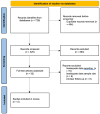Long-Term Effectiveness of Scleral Lens Treatment in the Management of Keratoconus: A Systematic Review
- PMID: 39781287
- PMCID: PMC11707714
- DOI: 10.7759/cureus.77102
Long-Term Effectiveness of Scleral Lens Treatment in the Management of Keratoconus: A Systematic Review
Abstract
This systematic review evaluates the long-term effectiveness of scleral lenses in improving visual outcomes, patient satisfaction, and safety in patients with keratoconus. A systematic search of six databases (PubMed, Embase, Web of Science, Scopus, Cochrane Library, and MEDLINE) was performed following Preferred Reporting Items for Systematic Reviews and Meta-Analyses (PRISMA) guidelines. The inclusion criteria included studies with more than or equal to three months of follow-up, included a minimum of 20 keratoconus patients, published after year 2020 and outcomes reporting visual acuity, comfort or quality of life. Methodological quality was assessed using the Newcastle-Ottawa Scale and Murad et al. case series tool. Five studies (463 eyes) met the inclusion criteria. Scleral lenses consistently improved best-corrected visual acuity (BCVA) across studies, with visual gains from baseline logMAR 0.50-0.53 to post-treatment logMAR 0.08-0.09. Significant improvements in vision-related quality of life (National Eye Institute Visual Function Questionnaire (NEI-VFQ) scores) were observed in validated assessments. Complications were infrequently reported but included lens handling issues (10.4%-63%), fogging (58%), and physiological events (e.g., corneal epitheliopathy). Long-term follow-up indicated that 14.6% of the patients experienced worsening visual acuity due to keratoconus progression. Methodological quality was variable, with limitations including variable outcome reporting and limited follow-up duration. Scleral lenses provide substantial and sustained improvements in visual acuity and quality of life for keratoconus patients, particularly those with advanced disease. However, the evidence is limited by methodological shortcomings and a lack of long-term controlled studies. Future research should prioritise randomised trials with standardised reporting and longer follow-up to better assess complications and durability of outcomes.
Keywords: corneal ectasia; keratoconus (kc); long-term outcome; scleral contact lens; systematic literature review.
Copyright © 2025, Mushtaq et al.
Conflict of interest statement
Conflicts of interest: In compliance with the ICMJE uniform disclosure form, all authors declare the following: Payment/services info: All authors have declared that no financial support was received from any organization for the submitted work. Financial relationships: All authors have declared that they have no financial relationships at present or within the previous three years with any organizations that might have an interest in the submitted work. Other relationships: All authors have declared that there are no other relationships or activities that could appear to have influenced the submitted work.
Figures
References
-
- Atypical unilateral superior keratoconus in young males. Weed KH, McGhee CN, MacEwen CJ. Cont Lens Anterior Eye. 2005;28:177–179. - PubMed
-
- Prevalence and associations of keratoconus in rural Maharashtra in central India: the central India eye and medical study. Jonas JB, Nangia V, Matin A, Kulkarni M, Bhojwani K. Am J Ophthalmol. 2009;148:760–765. - PubMed
-
- Prevalence of keratoconus in a population-based study in Shahroud. Hashemi H, Beiranvand A, Khabazkhoob M, Asgari S, Emamian MH, Shariati M, Fotouhi A. Cornea. 2013;32:1441–1445. - PubMed
Publication types
LinkOut - more resources
Full Text Sources
Miscellaneous

